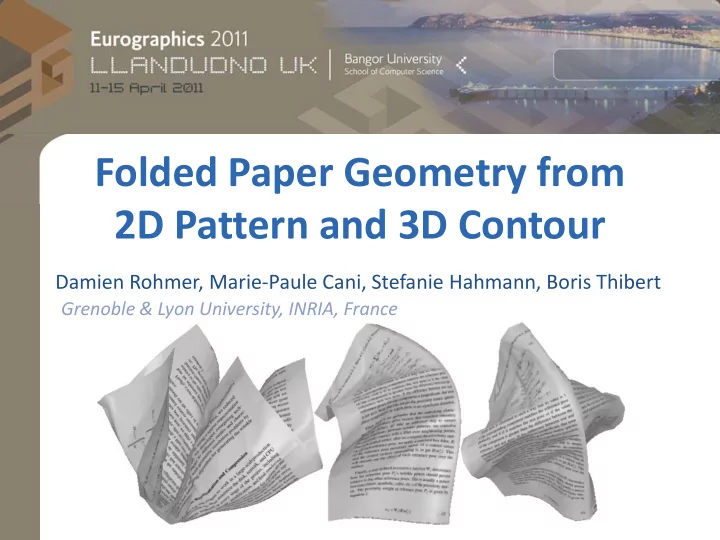

Folded Paper Geometry from 2D Pattern and 3D Contour Damien Rohmer, Marie-Paule Cani, Stefanie Hahmann, Boris Thibert Grenoble & Lyon University, INRIA, France
Folded Papers are rare in video-games & CG Movies • Few available modeling tools! – Non smooth – Isometry preserving 2D pattern • Goal: + Real pictures 3D boundary
Related Work • Physically based modeling Cloth simulators Thin plates from folds Specific spring-mass system [Choi, Ko; TOG 02] [Burgoon et al.; C&A 06] [Kang et al.; CASA 09] [English, Bridson; TOG 08] [Thomaszewski et al.; CGF 09] Slow, Smooth surface Folds are user defined Folds along existing edges
Related Work • Geometric approaches Developable construction Mesh deformation Procedural generation [Tang, Chen; TVCG 09] [Decaudin et al.; CGF 06] [Frey; CAD 04] [Popa et al.; CGF 09] [Rose et al.; SGP 07] Restricted to Slow, smooth surface Limited range of the convex hull deformation
Our Key Idea • New subdivision improving length preservation • Automatic generation of folding curves Folding curves 3D Pattern Preserved isometry Input
Overview • Divide & Conquer approach – Localize one fold – Compute optimal 3D profile – Divide Folding curve 3D profile Input = 2D pattern Subdivision steps … Final folded surface + 3D boundary curve
Recursive subdivision • Algorithm • Input 1. Localize fold curve – 2D Pattern = convex polygon 2. Split into two separated parts – 3D Boundary = 3D polyline 3. Restart at 1. on the two parts Loop until isometry is reached pattern 3D splitting Part 1 Part 2
Localizing fold line : straight line • Localize = Find good pair of vertices Case 1: L=L 0 L L 0 => 2D line mapped in 3D straight line Case 2: L<L 0 : 3D profile is not a straight line !
Localizing fold line: curved folds • Localize = Find pair of vertices with least compression Case 2: L<L 0 0 profile = cubic polynomial • precise : good approximation of conical section • robust : does not oscillate • fast : limited degrees of freedom
Computing folding profile Goal : Improve length preservation => Find the best profile improving length preservation Delaunay triangulation 0 Error in length E= S (L-L0) 2 Several possible curves
Computing folding profile Goal : Improve length preservation => Find the best profile improving length preservation before subdivision: Best profile = minimize the error • Optimization = non linear minimization E=f(curve) • 6 degrees of freedom per curve (2 tangents) • Curve is considered if E1<E0
Final surface 2D Delaunay 3D mapping triangulation Computed 3D curves
Results : Band strip Input Subdivision Our textured result
Results : comparison to real sheet Input Subdivision Our result Real example
Results : folded paper Input Subdivision Spring-mass Real paper Our result
Results: complex folded paper Input Subdivision Spring-mass Real paper Our result
Results: complex folded paper
Results: Real time capture
Results: Residual error Error Length 0.09 (0.21) 0.21 (0.25) 1.12 (2.2) 1.28 (2.5) Error Angle 0.16 (1.4) 0.35 (1.9) 2.52 (18.3) 2.89 (22.8) Error Area 0.7 (1.1) 1.3 (1.1) 6.0 (18) 8.0 (18) Time <0.1s <0.1s 0.2s 0.6s
Results: Extension to metal material Our result Input
Results: Robustness to extended/compressed 3D boundary Plausible folds Artificial 2D pattern compression 3D curve Flat surface Artificial 2D pattern extension 3D curve
Limitations Positional • Input constraints • Self collision Global linear relaxation • Error residual • Static only
Conclusion New subdivision algorithm • creates paper looking surface • almost isometry preserving Main ideas: • Localize the folds : least compression bw vertices • Find the best profile : minimizing length error + Fast + Non smooth surface + Adapted mesh
Thank you
Recommend
More recommend